Top 28 Most Popular Foods in Ghana: From the Gulf to the North
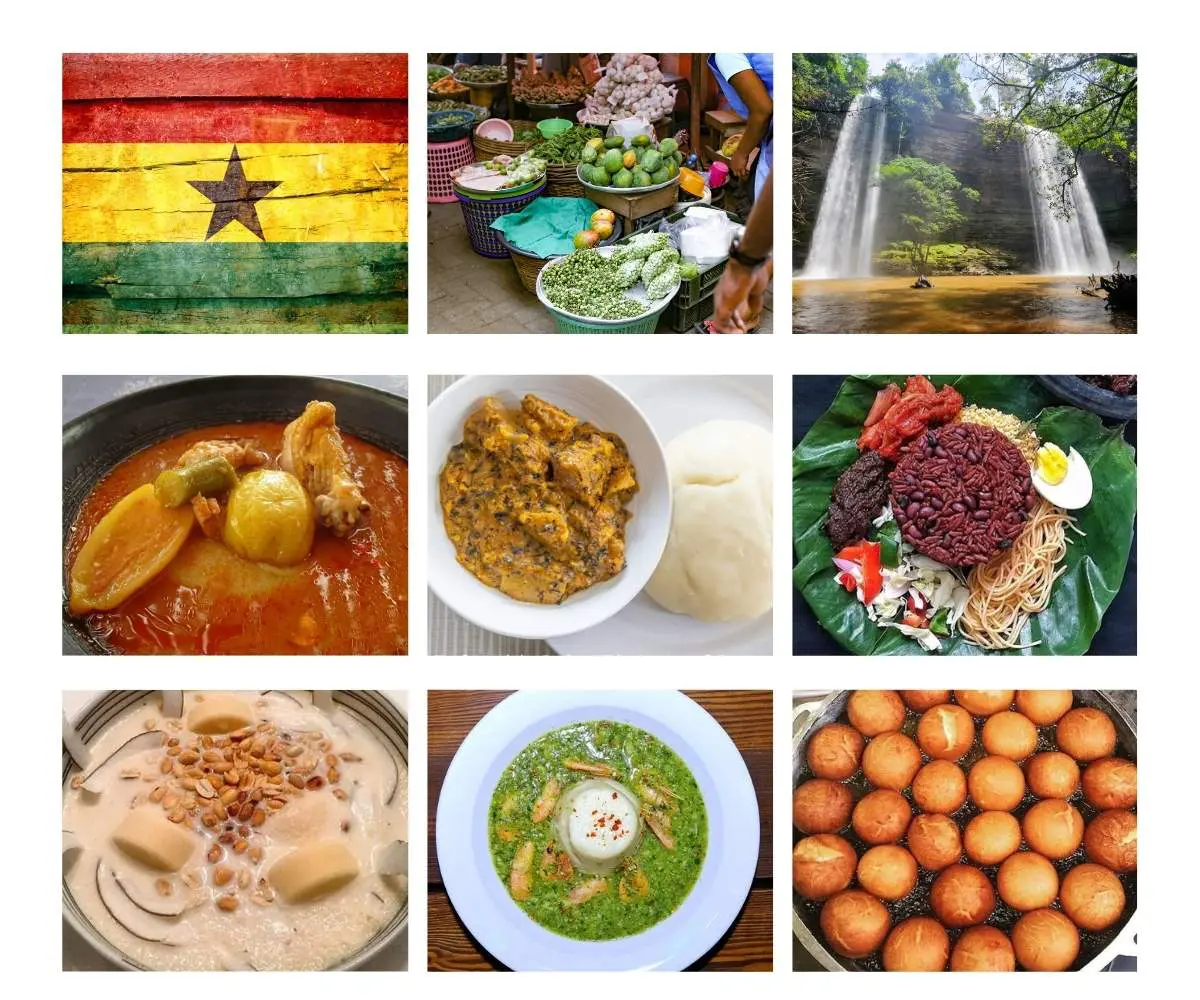
Ghana, though a relatively small country of just 30 million, was at the forefront of the struggle for independence from colonialism and the first sub-Saharan country to achieve it. It boasts such great leaders as Dr. Kwame Nkrumah, but it also boasts one of the best cuisines in West Africa.
This cuisine has made a name for itself in the culinary arts of the sub-region and is famous throughout the continent for its spicy soups, along with dishes primarily derived from corn and cassava (a root vegetable with rich carbohydrate content).
Ghana’s food is as diverse as its people, with every ethnic group having a special dish of their own. From the coastal towns to the savannah regions, there are a thousand and one different foods originating from all over this tropical country. Some dishes are famed for being simply delectable and are popular with almost all Ghanaians.
Here, we bring you 28 of the most popular dishes in Ghana. But before we begin, here’s a short guide to help you understand the food culture of the Star of Africa.
Just like the Europeans and North Americans, West Ghanaians enjoy a distinct breakfast, lunch, and supper. Though, there’s a clear distinction between what food can be eaten for breakfast and what can be eaten for lunch and supper, which can be eaten for both meals. It is rare for Ghanaians to eat lunch or supper foods for breakfast, though it has been known to happen.
Most Popular Soups in Ghana
Most meals will feature soup in Ghana. So, here is a list of the main soups that are generally loved by all from the Gulf to the North.
1. Peanut/Groundnut Butter Soup

Peanut/groundnut butter soup is made from, you guessed it, peanut butter. This creamy soup is created by mixing peanut butter with water and stirring till the oil in the peanut butter rises to the top.
This mixture is added to a base of boiled and blended tomatoes, pepper, onions, ginger, and garlic and cooked to give it its unique taste. You can add any meat or seafood of your choice.
2. Light Soup (Tomato Soup)
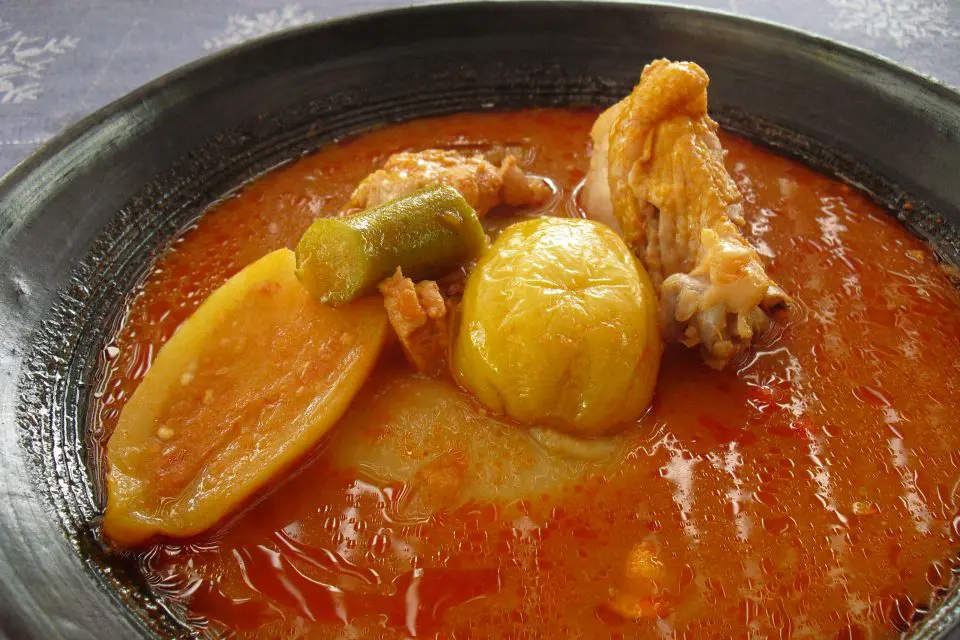
This is locally referred to as light soup because it is so much lighter than the thick and creamy peanut butter soup, though it is very spicy. Preparation is simple. Just boil peppers, tomatoes, and eggplant together, then blend, sieve, and add blended onions, garlic, and ginger.
The meat is steamed separately with spices to ensure it is soft and tasty before adding to the soup for its special aroma and flavor.
3. Okra Soup

There are two variants of this soup, one from the South and one from the North of the country. Southerners grow fresh okra, which they use for making this soup, while Northerners grow dry okra, due to the dry climate there. Okra is a vegetable that contains small white seeds surrounded by a slimy substance that becomes more pronounced when cooked. It’s often referred to as a “lady’s finger” due to its slim shape.
Having brought you the main popular soups in Ghana, let’s dive into the wider world of Ghanaian cuisine.
Many Ghanaian dishes don’t have equivalent English names, and neither do they have American or European ‘counterparts’. Yes, they are truly unique.
Breakfast
The breakfast you eat in Ghana depends on the type of work that you do. White-collar workers prefer a light breakfast with tea or a chocolate drink, and porridge with bread or biscuits. However, manual workers prefer something heavier to give them the energy they need, such as plain rice or beans with sauce or stew.
4. Koko with Koose/Bread (Corn Meal Porridge and Bean Cake/Bread)
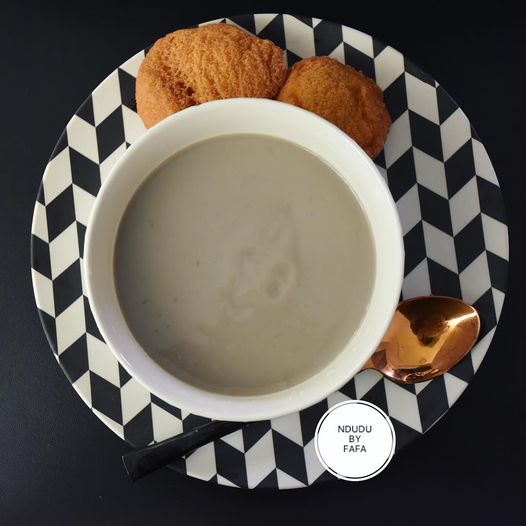
This dish is generally eaten for breakfast though it can be eaten at any time of the day. Queues are common in Ghana, and one of the most frequent ones is for Koko.
The dish is prepared with corn dough that has been left to ferment for a few days (approximately 3) to make it tastier; unfermented corn dough normally leaves a biting, sour taste in the mouth. The cornmeal porridge is normally accompanied by bean cakes or bread.
5. Hominy Corn Porridge
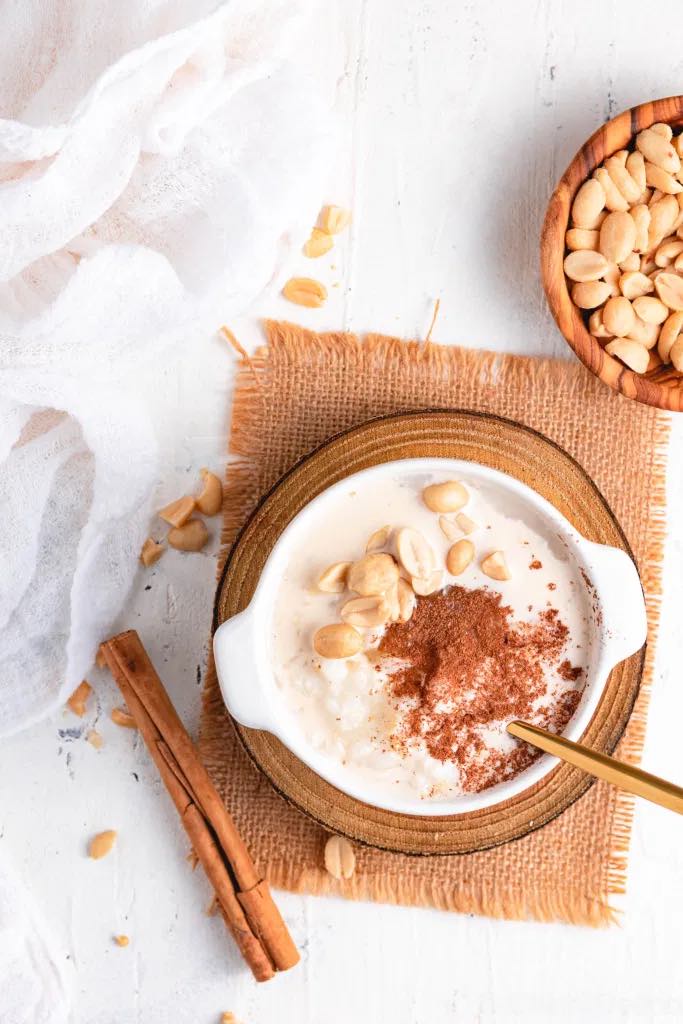
This widely popular breakfast is akin to European hominy grits. It is made from hominy corn (maize that’s been processed to make its kernels puffy and chewy), which is all you need to make this hearty breakfast. The corn is boiled in water for a few hours to soften and then your meal is ready.
Hominy corn porridge is a little tangy, so people often add milk and sugar to sweeten it. While the children love the taste, the adults love that it is packed with nutrients.
6. Rice Water Porridge

Another plain but nutritious breakfast is rice water porridge. Very popular in the Southern and Middle belts of Ghana, this simple but delightful breakfast only requires three ingredients – water, salt, and rice. Most people usually add milk and sugar to sweeten it, but unlike hominy corn porridge, it can be eaten without.
Lunch/Dinner
Lunch and dinner are the most important meals for a Ghanaian. As mentioned earlier, there’s no difference between the dishes prepared for lunch and those prepared for supper – they are interchangeable.
7. Banku with Soup and Seafood

Banku is a combination of fermented corn dough and cassava dough which is mixed and stirred in hot water till it becomes solid.
It is a very common dish in the Southern, Eastern, and Western parts of Ghana. Banku is eaten along with different kinds of soups, stews, and sauces – from peanut-butter soup to pounded palm nut soup.
However, the most popular soup that resonates well with Banku is okra stew or soup. Cowskin, locally called Wele, is added along with any seafood of your choice.
8. Fufu and Soup

This is a popular dish across the country and its neighbors. It is called Foufou or Foutou in Francophone countries while the English-speaking countries, such as Nigeria, call it Fufu.
Prepared from a combination of boiled tropical cassava and plantain or yam, which is pounded to a pulp, it is mostly eaten with a light soup. Yams are often cultivated in Africa. They are vegetables that grow in tropical and subtropical regions and they can be cooked in various ways, such as boiling, frying, or roasting.
Fufu can also be eaten with peanut butter soup, pounded palm nut soup, and vegetable soup made from either spinach or cocoyam leaves (leaves from the cocoyam plant, commonly used in African and Asian cooking).
The most delicious Fufu with soup dish features snails, mushrooms, and fish.
9. Waakye (Rice and Beans with Millet Leaves)

This is one of the most adored dishes in households across Ghana. The rice and beans are boiled in water with leaves from the cocoyam plant till they become soft.
Millet leaves are edible leaves from millet plants, commonly found in parts of Africa and Asia. They are locally referred to as Waakye, which is where the name of the dish comes from. It is normally accompanied by yellowish granulated cassava, tomato sauce, and a hot black pepper sauce called shito. Beef or eggs are also added, though sometimes you will find it with chicken or guinea fowl.
10. Rice Balls (Omotuo) with Peanut Butter Soup

Southerners love this dish so much that they have dedicated a special day for eating it – Sunday afternoons. Some local restaurants, popularly known as Chop Bars, will only serve this food on Sundays.
Omotuo is made from boiled rice which is formed into small balls. When cooked properly, the balls become soft and smooth, making them easy to gulp down with peanut butter soup. To top it all off, this dish is served with a mix of offal.
11. Etor (Mashed Yam with Eggs)

Mashed yam with eggs is widely referred to as food for the gods due to being served on religious occasions. However, if you aren’t religious, you can eat it as and when you choose.
It is easy to prepare but very tasty – which may be why the gods love it. Just boil yam till it’s soft and then mash it. Add hot palm oil and some boiled eggs and there you go. Food for the gods ready for enjoying by us mortals.
12. Yam Pottage

Like many other staple foods in Ghana, yam can be used to prepare a variety of meals and includes Yam Pottage. Yam pottage is yam infused with tomato soup and flavored with dry sardines and garlic.
Since there are various varieties of Yam Pottage (sometimes called yam porridge), you are at liberty to cook it whichever way you want. Some use palm oil instead of tomato soup, and dried sardines or salted dry tilapia (a common freshwater fish enjoyed globally) can be added, giving it a mouthwatering aroma.
13. Tuo Zaafi
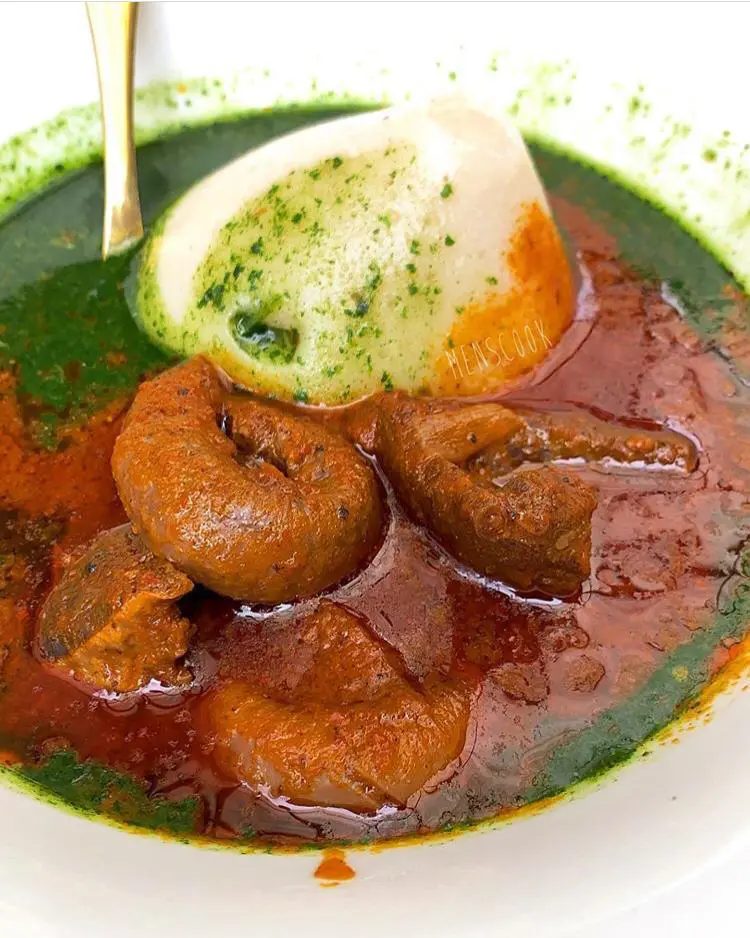
Tou Zaafi, widely known as TZ, is very common in the North, especially the Dagombas. Prepared from dry cornflour, it does require a bit of skill to get right. Soft and spongy, like Banku and Fufu, it goes well with a good soup.
The most popular soup that comes with TZ is jute leaf soup known as Ayoyo. But they equally go well with tomato stew.
14. Tubaani (Bean Pudding)

Tubaani is another dish popular with the people of Northern Ghana but is also enjoyed by those of the Zongo communities in the South. It has a very distinct, pleasant, and welcoming aroma.
Made from ground black-eyed peas or beans, it is mixed with water and stirred into a pudding. Then it is steamed over boiling water and served with fried onions and pepper.
15. Wasawasa (Yam Flour Meal)
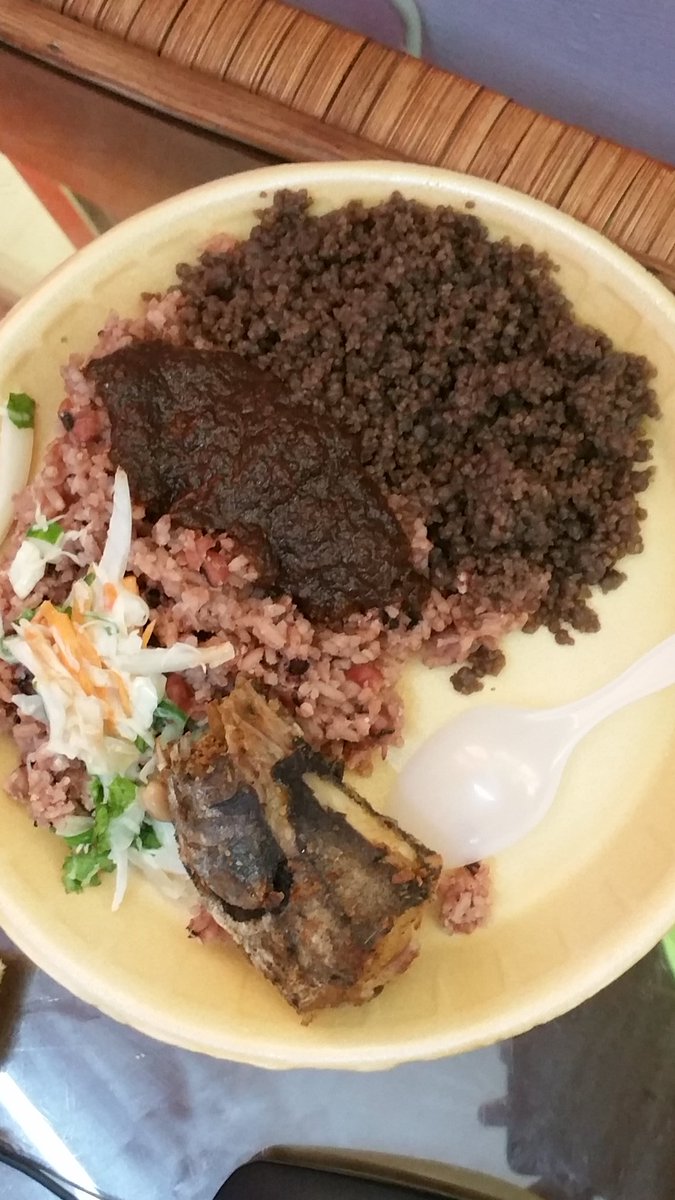
This is one of the most revered foods in the North. It is said that the dish will be sour and tasteless if your home is filthy. So, many people take the opportunity to do a deep clean before preparing a pot of Wasawasa.
It is prepared from ground yam flour, which turns a deep dark brown as it cooks and forms tiny black balls. It is a very sweet taste and goes well with hot black pepper and stew garnished with sliced onions and tomatoes.
16. Plantain and Kontomire Stew (Plantain and Cocoyam Leaf Stew)

Like many Ghanaian foods, plantain and cocoyam leaves are eaten fresh from the farm. The sight and smell of fresh cocoyam leaves and plantain is simply mouthwatering, especially as you can expect to get a dish prepared in less than an hour.
The plantain is peeled and boiled while the cocoyam leaves are cut, boiled, and then ground in a locally made earthenware bowl called an Apotoyiwa. Hot palm oil is added to the leaves with salted tilapia and boiled eggs. The fried oil and salted fish produce a very strong and pleasant aroma that can bring the flies, so it’s best to eat it indoors.
17. Yam Fries and Octopus

Yam fries are cooked till they are crisp and eaten with tomato sauce or shito, the very famous black pepper sauce. Shito is prepared by mixing black peppers, chili peppers, onions, garlic, fish or seafood, and spices. This mixture is cooked to create a spicy condiment for meals.
Octopus is the favorite for putting alongside the fries, but fish and even fried chicken or beef go well too.
Yam fries can be found in all the major towns in Ghana, including tourist centers. They are cheap, easy to prepare, and ready to go.
18. Jollof

A whole book could be written about this West African dish. Its origin has always been hotly debated, with Nigeria, Senegal, and Ghana all claiming ownership of the famed rice dish.
This sweet meal is made by simply boiling rice in a tomato stew till it is nicely cooked. It is the perfect side dish to go with chicken, goat, or beef and a good crisp salad.
16. Akple with Okra Soup
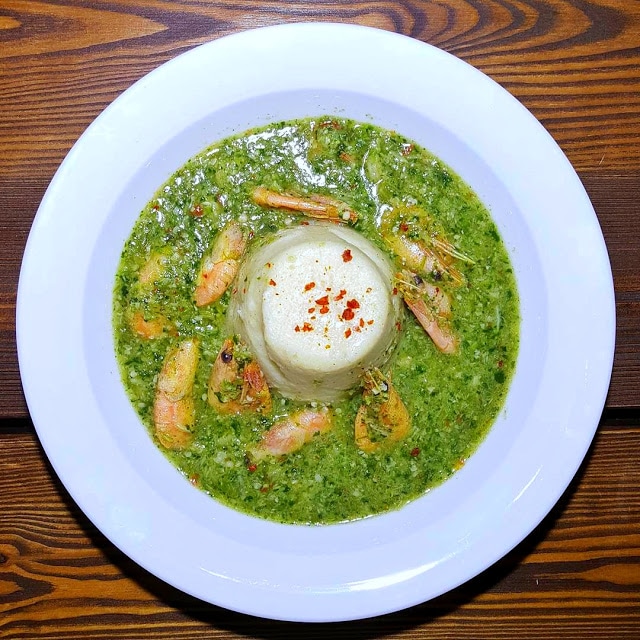
Akple is very common in the Volta Region of Ghana. It is very similar to Banku, using much the same ingredients. However, corn dough is used to make Banku while cornflour is used for Akple.
In the southern Volta Region, they prefer their Akple with okra soup and crabs whilst in the North, pepper sauce and anchovies are preferred.
20. Kokonte

The one delicacy that is popular throughout all of Ghana is Kokonte. The main ingredient, cassava, grows in nearly every region of the country so pretty much every tribe has its own version of the dish. The dish has several nicknames, which attest to the fondness people have for it: “Face The Wall”, “Black Gold”, and “Agyenkwa” (savior).
Kokonte is normally served up with peanut butter soup – they make a perfect match. However, it also does well with other soups such as Palm Kernel and Okra soups, and with assorted fish or meat. Others prefer a simple pepper sauce and anchovies.
21. Angwamu (Oil Rice) Baby Rice

Ghanaian oil rice, called Angwamu in the South and baby rice in the North, is probably one of the simplest dishes to prepare. All you need is water, vegetable oil, salt, and onions and within thirty minutes your food is ready.
It is enjoyed by people of all ages but is highly recommended for babies, which is why it is called baby rice, of course. This delicious dish is eaten with pepper sauce and fried eggs or sardines and is so delicious it will leave you wanting more.
22. Kenkey

Kenkey is another delicacy that unites the people of Ghana as it can be found virtually everywhere. This dish of corn dough prepared in dry corn husks is locally called Komi or Dorkunu.
Delicious as it is, it is also rather tedious to prepare, so best not to start it when you are tired or hungry. Best, in fact, to get it from street vendors, which most people do, served with pepper sauce, hot black pepper sauce (shito), and fried fish.
Most Popular Snacks
Snacks are very common in this West African country. They are mostly sold along the streets and one can grab them for less than a dollar. Let’s take a quick look at some of them.
23. Plantain Chips

This is a very common snack that is loved by all and sundry. It comes in two flavors: ripe and unripe. Both are very tasty but many prefer the ripe plantain chips due to their extra sweetness.
Plantain chips are prepared in a similar way to French fries. The plantain is peeled and sliced into flat chips, salted, and fried till they are crisp. A sweet and crunchy treat for less than a dollar.
24. Bofrot (Fried Donuts)

Ghana has its own donut called Bofrot. It is a very common snack sold along with Koko (corn dough porridge). It is prepared by mixing flour, eggs, vegetable oil, and dry yeast, then deep-frying till it turns deliciously golden brown.
Bofrot is difficult to make so best leave it to the expert street sellers, where you can enjoy it throughout the day, though it is usually eaten for breakfast.
25. Bean Cakes (Koose)

Since Ghana grows a wide range of beans and cowpeas, many dishes feature these as the main ingredients. A prime example is bean cakes, eaten with a porridge of corn dough or millet.
They are very popular in the northern parts but can also be found in the major cities. When fried properly, bean cakes have a crunchy outer layer and a soft core. Some people add pepper to make it a bit spicy and to enhance the taste, but they also taste just fine.
26. Agbeli Kaklo

Agbeli is a Ewe word for cassava. There is no English equivalent as the root is indigenous to Ghana. Agbeli Kaklo originated with the Ewe tribe but has become very popular on the streets of the capital city, Accra.
The dish is made with grated cassava, which is salted and fried. Crisp and crunchy, with a firm outer layer and soft inside, this sweet snack is eaten with coconut.
27. Nkatie Cake (Peanut Cake)

Nkatie, a Twi word for peanut, is made into a candy bar by grinding and mixing with melted sugar. Being so sweet, it is a very popular snack with school children. Nkatie cake has transcended all regional and national borders, with Guinea and Senegal even adopting this delicious snack.
28. Gari (Granulated Cassava) Soaking

Gari soaking is the Ghanaian version of cornflakes. It is a very simple food that can be eaten as lunch or as a snack. The name gari soaking pretty much describes the dish. Gari (granulated cassava) is soaked in water and eaten with peanuts and sugar, with optional salt.
It is very delicious and probably the cheapest dish on the list, making it very common throughout the country. Students especially love it, calling it the “student’s companion” or the “life saver”.
Called the Gateway to Africa, because of its hospitality, Ghana is home to a diverse array of cultures and many interesting traditions, and the food here is as unique as its people.
Ghana attracts over a million tourists a year and is happy to welcome even more. A recent event, the Year of Return, saw tourists flood the nation to bask in the glory of its warm sun and experience the culture, traditions, and cuisine. Though a small country, it has a big heart – open to everyone.
Related: Most Popular Christmas Foods in Ghana


